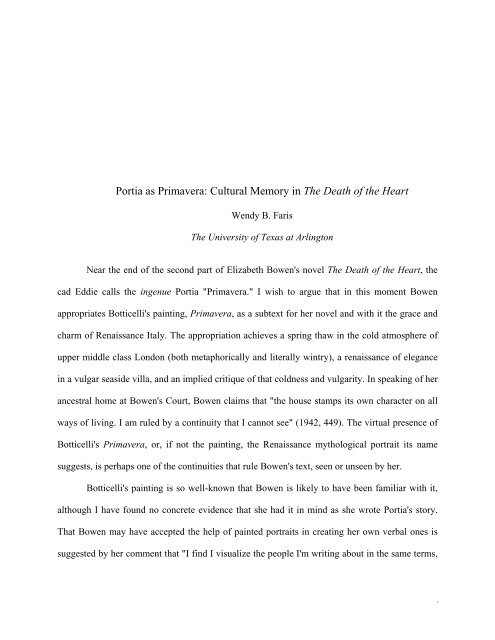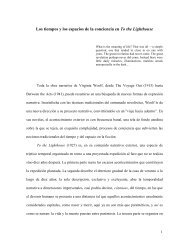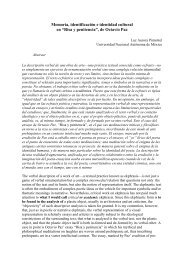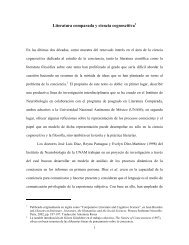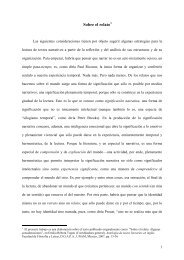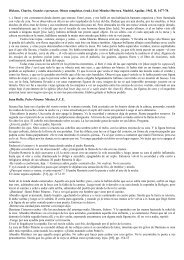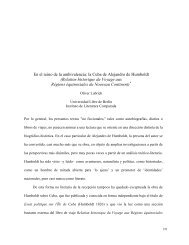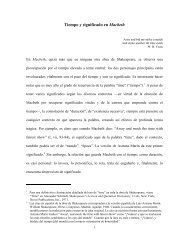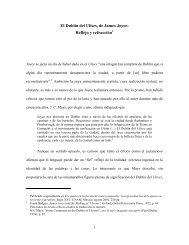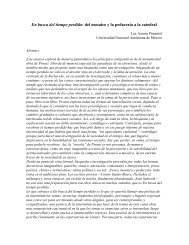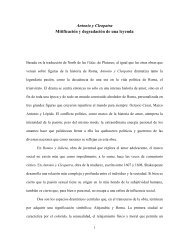Portia as Primavera: Cultural Memory in The Death of the Heart
Portia as Primavera: Cultural Memory in The Death of the Heart
Portia as Primavera: Cultural Memory in The Death of the Heart
You also want an ePaper? Increase the reach of your titles
YUMPU automatically turns print PDFs into web optimized ePapers that Google loves.
<strong>Portia</strong> <strong>as</strong> <strong>Primavera</strong>: <strong>Cultural</strong> <strong>Memory</strong> <strong>in</strong> <strong>The</strong> <strong>Death</strong> <strong>of</strong> <strong>the</strong> <strong>Heart</strong>Wendy B. Faris<strong>The</strong> University <strong>of</strong> Tex<strong>as</strong> at Arl<strong>in</strong>gtonNear <strong>the</strong> end <strong>of</strong> <strong>the</strong> second part <strong>of</strong> Elizabeth Bowen's novel <strong>The</strong> <strong>Death</strong> <strong>of</strong> <strong>the</strong> <strong>Heart</strong>, <strong>the</strong>cad Eddie calls <strong>the</strong> <strong>in</strong>genue <strong>Portia</strong> "<strong>Primavera</strong>." I wish to argue that <strong>in</strong> this moment Bowenappropriates Botticelli's pa<strong>in</strong>t<strong>in</strong>g, <strong>Primavera</strong>, <strong>as</strong> a subtext for her novel and with it <strong>the</strong> grace andcharm <strong>of</strong> Renaissance Italy. <strong>The</strong> appropriation achieves a spr<strong>in</strong>g thaw <strong>in</strong> <strong>the</strong> cold atmosphere <strong>of</strong>upper middle cl<strong>as</strong>s London (both metaphorically and literally w<strong>in</strong>try), a renaissance <strong>of</strong> elegance<strong>in</strong> a vulgar se<strong>as</strong>ide villa, and an implied critique <strong>of</strong> that coldness and vulgarity. In speak<strong>in</strong>g <strong>of</strong> herancestral home at Bowen's Court, Bowen claims that "<strong>the</strong> house stamps its own character on allways <strong>of</strong> liv<strong>in</strong>g. I am ruled by a cont<strong>in</strong>uity that I cannot see" (1942, 449). <strong>The</strong> virtual presence <strong>of</strong>Botticelli's <strong>Primavera</strong>, or, if not <strong>the</strong> pa<strong>in</strong>t<strong>in</strong>g, <strong>the</strong> Renaissance mythological portrait its namesuggests, is perhaps one <strong>of</strong> <strong>the</strong> cont<strong>in</strong>uities that rule Bowen's text, seen or unseen by her.Botticelli's pa<strong>in</strong>t<strong>in</strong>g is so well-known that Bowen is likely to have been familiar with it,although I have found no concrete evidence that she had it <strong>in</strong> m<strong>in</strong>d <strong>as</strong> she wrote <strong>Portia</strong>'s story.That Bowen may have accepted <strong>the</strong> help <strong>of</strong> pa<strong>in</strong>ted portraits <strong>in</strong> creat<strong>in</strong>g her own verbal ones issuggested by her comment that "I f<strong>in</strong>d I visualize <strong>the</strong> people I'm writ<strong>in</strong>g about <strong>in</strong> <strong>the</strong> same terms,257
That Bowen is likely to adopt a Renaissance pa<strong>in</strong>t<strong>in</strong>g <strong>as</strong> a foil for modernity is confirmedby her fondness for her ancestral home, Bowen's Court, <strong>of</strong> which she says, "<strong>the</strong>re is no house likeBowen's Court, with its great pale Renaissance pla<strong>in</strong>ness set under near mounta<strong>in</strong>s amongshower<strong>in</strong>g trees," and <strong>the</strong> way <strong>in</strong> which she compares its surround<strong>in</strong>gs to modern England: "Thatair <strong>of</strong> w<strong>as</strong>te and nonchalance about Irish ru<strong>in</strong>s is an irritant to <strong>the</strong> present day English m<strong>in</strong>d. Butwhen fancy loomed larger than economics, when f<strong>in</strong>e degrees <strong>of</strong> melancholy were sought,travellers turned on our ru<strong>in</strong>s a much more complaisant eye" (1942, 108, 116). 2Morespecifically, <strong>in</strong> a letter to Lady Ottol<strong>in</strong>e Morrell, Bowen describes a marriage <strong>in</strong> terms that recall<strong>the</strong> mode <strong>of</strong> Botticelli's <strong>Primavera</strong>, itself thought to have been pa<strong>in</strong>ted for <strong>the</strong> occ<strong>as</strong>ion <strong>of</strong>Lorenzo di Pierfrancesco's wedd<strong>in</strong>g to Semiramide: "David's wedd<strong>in</strong>g w<strong>as</strong> just <strong>as</strong> it should be –graceful, formal, romantic, utterly unsentimental. Cynthia Asquith said 'Like <strong>the</strong> marriage <strong>of</strong> apair <strong>of</strong> royal children' –and it w<strong>as</strong>. Like a little Valois marry<strong>in</strong>g a still younger Vel<strong>as</strong>quez (sic)pr<strong>in</strong>cess. And both looked transparent and serious, like a pair <strong>of</strong> children." 3 <strong>The</strong> transparent,graceful, serious, and fresh quality that Bowen admires <strong>in</strong> this young couple is what <strong>Portia</strong> <strong>as</strong><strong>Primavera</strong> represents, <strong>in</strong> contr<strong>as</strong>t to <strong>the</strong> world around her. In contr<strong>as</strong>t to <strong>the</strong> o<strong>the</strong>r Renaissancetext evoked specifically <strong>in</strong> <strong>the</strong> novel, <strong>the</strong> "Elizabethan play," <strong>in</strong> which children are led on and <strong>of</strong>f,"bound for some tragic fate which will be told <strong>in</strong> a l<strong>in</strong>e," this visual one allows <strong>Portia</strong> morescope, but pictures it with<strong>in</strong> a graceful paradigm (297-98). 4A major way <strong>in</strong> which this visual subtext from ano<strong>the</strong>r era illum<strong>in</strong>ates Bowen's novel canbe found <strong>in</strong> <strong>the</strong> neoplatonic philosophy contemporaneous with <strong>the</strong> pa<strong>in</strong>t<strong>in</strong>g. A neoplatonic<strong>in</strong>terpretation <strong>of</strong> Botticelli's pa<strong>in</strong>t<strong>in</strong>g reveals that its movement is orchestrated from right to left,follow<strong>in</strong>g <strong>the</strong> impetus <strong>of</strong> Zephyr's breath, and that this movement corresponds to <strong>the</strong> soul'sprogress from <strong>the</strong> birth and blossom<strong>in</strong>g <strong>of</strong> physical desire <strong>in</strong> <strong>the</strong> first two female figures to <strong>the</strong>right, through its fulfillment on earth <strong>in</strong> <strong>the</strong> figure <strong>of</strong> Venus <strong>as</strong> Harmony at <strong>the</strong> center, and its259
f<strong>in</strong>al transformation through <strong>the</strong> generous love <strong>of</strong> <strong>the</strong> three graces to <strong>the</strong> left, <strong>in</strong>to <strong>the</strong> <strong>in</strong>tellectualand contemplative plane <strong>in</strong>dicated by <strong>the</strong> figure <strong>of</strong> Mercury po<strong>in</strong>t<strong>in</strong>g upward (see figure 1). 5A related neoplatonic echo is that <strong>in</strong> pa<strong>in</strong>t<strong>in</strong>g <strong>Portia</strong> <strong>as</strong> <strong>Primavera</strong>, Bowen sublim<strong>in</strong>allyduplicates Fic<strong>in</strong>o's doctr<strong>in</strong>e that <strong>the</strong> direct vision <strong>of</strong> virtue w<strong>as</strong> more effective than verbalarguments. This is <strong>the</strong> effect that view<strong>in</strong>g <strong>Portia</strong> <strong>as</strong> <strong>Primavera</strong> and read<strong>in</strong>g her diary with itsdirect portraits <strong>of</strong> her adopted family h<strong>as</strong> on <strong>the</strong> jaded social world that she enters. She and hertext are direct visions <strong>of</strong> virtue ra<strong>the</strong>r than abstract arguments <strong>in</strong> its favor. <strong>The</strong> subtle clarity <strong>of</strong><strong>the</strong> Renaissance allegorical visual style provides a critique <strong>of</strong> <strong>the</strong> modernist verbal cleverness thatSt. Quent<strong>in</strong> and Eddie represent. Talk<strong>in</strong>g with <strong>Portia</strong>, St. Quent<strong>in</strong> says about his own novels that"what's <strong>in</strong> <strong>the</strong>m never happened – It might have, but never did. And though what is felt <strong>in</strong> <strong>the</strong>m isjust possible –<strong>in</strong> fact, it's much more possible, <strong>in</strong> an unnerv<strong>in</strong>g way, than most people will admit–it's fairly improbable" (249).Even leav<strong>in</strong>g <strong>as</strong>ide <strong>the</strong> neoplatonic philosophical context, Botticelli's pa<strong>in</strong>t<strong>in</strong>g isespecially appropriate for this story <strong>of</strong> <strong>the</strong> progress <strong>of</strong> a young girl because it presents <strong>the</strong>progressive com<strong>in</strong>g <strong>of</strong> spr<strong>in</strong>g. Fur<strong>the</strong>rmore, while <strong>the</strong> entire pa<strong>in</strong>t<strong>in</strong>g evokes a general sense <strong>of</strong>spr<strong>in</strong>gtime temporal progression and harmony ra<strong>the</strong>r than narrat<strong>in</strong>g a particular mythologicalnarrative, <strong>the</strong> one mythological story Botticelli does <strong>in</strong>clude corresponds to <strong>Portia</strong>'s age. This is<strong>the</strong> transformation <strong>of</strong> Chloris <strong>in</strong>to Flora follow<strong>in</strong>g Zephyr's pursuit <strong>of</strong> her, which is depicted <strong>in</strong><strong>the</strong> female figures to <strong>the</strong> right, Chloris hav<strong>in</strong>g only a few flowers spr<strong>in</strong>g<strong>in</strong>g from her mouth, andFlora, on <strong>the</strong> o<strong>the</strong>r hand, fully flower<strong>in</strong>g. <strong>The</strong> place <strong>of</strong> <strong>the</strong> right k<strong>in</strong>d <strong>of</strong> love <strong>in</strong> this process <strong>of</strong>transformation is implied <strong>in</strong> <strong>the</strong> neoplatonic <strong>in</strong>terpretation <strong>of</strong> <strong>the</strong> pa<strong>in</strong>t<strong>in</strong>g, which provides aphilosophical backdrop for Eddie's <strong>in</strong>adequacies <strong>as</strong> a suitably platonic and generative lover.In <strong>the</strong> <strong>Primavera</strong> taken <strong>as</strong> a whole, Zephyr's breath personifies time, which flows through<strong>the</strong> pa<strong>in</strong>t<strong>in</strong>g from right to left, draw<strong>in</strong>g leaves and flowers from early to full spr<strong>in</strong>g, and <strong>the</strong>n260
through summer to autumn. Similarly, Bowen charts <strong>the</strong> p<strong>as</strong>sage <strong>of</strong> time with se<strong>as</strong>onaldescriptions at <strong>the</strong> beg<strong>in</strong>n<strong>in</strong>g <strong>of</strong> each <strong>of</strong> <strong>the</strong> novel's parts, and additional references throughout,which chart <strong>the</strong> progress <strong>of</strong> spr<strong>in</strong>g <strong>in</strong> London. But that progress, like <strong>Portia</strong>'s development, isawkward and <strong>in</strong>terrupted, <strong>the</strong> modern appropriation <strong>of</strong> <strong>the</strong> Renaissance necessarily <strong>in</strong>complete.At <strong>the</strong> level <strong>of</strong> cultural archeology, besides represent<strong>in</strong>g a long<strong>in</strong>g for Renaissance grace andneoplatonic ideals, perhaps this nearly secret analogy between <strong>Portia</strong> and <strong>Primavera</strong> encloses anostalgia for <strong>the</strong> complex web <strong>of</strong> resemblances that Foucault characterizes <strong>as</strong> <strong>the</strong> Renaissanceepisteme and which, once aga<strong>in</strong>, contr<strong>as</strong>ts with <strong>the</strong> emotional and physical dislocations <strong>of</strong>modernity (Foucault 1973, 17-34).That <strong>in</strong> addition to symboliz<strong>in</strong>g spr<strong>in</strong>g, <strong>the</strong> <strong>Primavera</strong> is also sometimes seen <strong>as</strong>represent<strong>in</strong>g Florence, enriches Bowen's critique <strong>of</strong> a sector <strong>of</strong> London society. Anna's smallcircle <strong>of</strong> mediocre artists is a clique not a court, and if its surround<strong>in</strong>gs may be beg<strong>in</strong>n<strong>in</strong>g t<strong>of</strong>lower physically, <strong>the</strong>y, unlike Lorenzo's court, which w<strong>as</strong> flourish<strong>in</strong>g with new and fruitful ide<strong>as</strong>at <strong>the</strong> time <strong>of</strong> Botticelli's pa<strong>in</strong>t<strong>in</strong>g, are not flourish<strong>in</strong>g <strong>in</strong>tellectually, artistically, or emotionally.Thus, broaden<strong>in</strong>g our focus, we can consider <strong>the</strong> <strong>Primavera</strong> <strong>as</strong> represent<strong>in</strong>g not only <strong>the</strong> p<strong>as</strong>sage<strong>of</strong> <strong>the</strong> se<strong>as</strong>ons but also <strong>as</strong> <strong>the</strong> evocation <strong>of</strong> an ideal society. It would <strong>the</strong>n picture <strong>the</strong> reign <strong>of</strong>Venus-Humanit<strong>as</strong> (hardly Anna's mythological portrait), or civilization, which throughneoplatonic doctr<strong>in</strong>e is jo<strong>in</strong>ed to a heavenly realm. 6This ideal does not exist for <strong>Portia</strong> <strong>in</strong>London, where her ma<strong>in</strong> <strong>in</strong>tellectual pursuits –at <strong>the</strong> socially pretentious but artistically and<strong>in</strong>tellectually un<strong>in</strong>spir<strong>in</strong>g Miss Paullie's school– are undertaken underground, <strong>the</strong> polar opposite<strong>of</strong> <strong>the</strong> heavenly realm signaled by Mercury <strong>in</strong> Botticelli's pa<strong>in</strong>t<strong>in</strong>g.Botticelli's Chloris, with her sprig <strong>of</strong> foliage represent<strong>in</strong>g early spr<strong>in</strong>g, corresponds to<strong>Portia</strong> just after she arrives at Anna's house wear<strong>in</strong>g her mourn<strong>in</strong>g black, and Anna, blow<strong>in</strong>g onher, immediately outfits her <strong>in</strong> colors. <strong>The</strong> novel's <strong>in</strong>itial scene beg<strong>in</strong>s before that po<strong>in</strong>t, however,261
ecause Anna's read<strong>in</strong>g <strong>of</strong> <strong>Portia</strong>'s diary, which <strong>in</strong>augurates <strong>Portia</strong>'s irruption <strong>in</strong>to Anna's frigidsocial world, takes a while to have an effect. Although <strong>in</strong> <strong>the</strong> first paragraph <strong>of</strong> <strong>the</strong> novel (at <strong>the</strong>start <strong>of</strong> <strong>the</strong> part entitled "<strong>The</strong> World"), <strong>the</strong> "morn<strong>in</strong>g's ice, no more than a brittle film, hadcracked and w<strong>as</strong> now float<strong>in</strong>g <strong>in</strong> segments," <strong>as</strong> if <strong>in</strong> anticipation <strong>of</strong> <strong>Portia</strong>'s shatter<strong>in</strong>g <strong>of</strong> Anna'semotionally frozen world, by <strong>the</strong> end <strong>of</strong> <strong>the</strong> paragraph which describes <strong>the</strong> "bronze cold <strong>of</strong>January," whose "sky w<strong>as</strong> shut to <strong>the</strong> sun," we hear that "it would freeze harder tonight." Spr<strong>in</strong>g'sarrival, while foreshadowed, h<strong>as</strong> not really begun to occur.<strong>The</strong> beg<strong>in</strong>n<strong>in</strong>g <strong>of</strong> Part 2, "<strong>The</strong> Flesh," forms a se<strong>as</strong>onal contr<strong>as</strong>t, and a direct analogue to<strong>Portia</strong>'s arrival at <strong>the</strong> Quaynes’ house. It is early March when "<strong>the</strong> crocuses crept alight, <strong>the</strong>nblazed yellow and purple <strong>in</strong> <strong>the</strong> park." <strong>The</strong> bright colors suggest <strong>Portia</strong>'s irrepressibly criticalspirit, but after that <strong>in</strong>itial fl<strong>as</strong>h <strong>of</strong> color, Bowen cont<strong>in</strong>ues her pa<strong>in</strong>terly description with moreattention to <strong>the</strong> quality <strong>of</strong> light. She pa<strong>in</strong>ts <strong>the</strong> com<strong>in</strong>g <strong>of</strong> spr<strong>in</strong>g with an attention to se<strong>as</strong>onalmovement and delicately described detail that are analogous to Botticelli's carefully orchestratedse<strong>as</strong>onal observation expressed <strong>in</strong> f<strong>in</strong>ely pa<strong>in</strong>ted leaves and flowers:it is about five o'clock <strong>in</strong> an even<strong>in</strong>g that <strong>the</strong> first hour <strong>of</strong> spr<strong>in</strong>g strikes . . . . <strong>The</strong> air,about to darken, quickens and is run through with mysterious white light; <strong>the</strong> curta<strong>in</strong> <strong>of</strong>darkness is suspended, <strong>as</strong> though for some unprecedented event. <strong>The</strong>re is perhaps nosunset, <strong>the</strong> trees are not yet budd<strong>in</strong>g –but <strong>the</strong> senses receive an <strong>in</strong>timation, an <strong>in</strong>timationso f<strong>in</strong>e, yet strik<strong>in</strong>g <strong>in</strong> so directly, that this appears a movement <strong>in</strong> one's own spirit. Thisexalts whatever feel<strong>in</strong>g is <strong>in</strong> <strong>the</strong> heart. (123)By now <strong>the</strong> reader hopes that this spr<strong>in</strong>gtime exaltation may reach even Anna. <strong>The</strong>references to a "mysterious" white light, to a movement <strong>of</strong> <strong>the</strong> spirit, and to exaltation,correspond to <strong>the</strong> neoplatonic echoes <strong>in</strong> <strong>the</strong> <strong>Primavera</strong>. And <strong>as</strong> if to recall Botticelli's pa<strong>in</strong>t<strong>in</strong>gexplicitly, Bowen personifies spr<strong>in</strong>g and refers to <strong>the</strong> two ph<strong>as</strong>es represented by Flora and262
Chloris that <strong>the</strong> pa<strong>in</strong>t<strong>in</strong>g records: "<strong>The</strong> later ph<strong>as</strong>es <strong>of</strong> spr<strong>in</strong>g, when her foot is <strong>in</strong> at <strong>the</strong> door, aremet with a conventional gaiety. But her first unavowed presence is disconcert<strong>in</strong>g" (123). <strong>The</strong>parallel to <strong>Portia</strong>'s disconcert<strong>in</strong>g arrival is clear.In addition to this temporal similarity, <strong>the</strong>re are structural parallels <strong>as</strong> well, which fur<strong>the</strong>rconfirm <strong>the</strong> deep aff<strong>in</strong>ity between <strong>The</strong> <strong>Death</strong> <strong>of</strong> <strong>the</strong> <strong>Heart</strong> and <strong>Primavera</strong>. As <strong>in</strong> Botticelli'spa<strong>in</strong>t<strong>in</strong>g, <strong>in</strong> which <strong>the</strong> central space is divided between <strong>the</strong> more mature figure <strong>of</strong> Venus and <strong>the</strong>lighter colored and yet more enchant<strong>in</strong>g figure <strong>of</strong> Flora, Bowen's novel is divided <strong>in</strong> its centralfocalizations between Anna and <strong>Portia</strong>. Apparently, Flora enjoyed more popularity <strong>in</strong> Florence <strong>as</strong>a symbol <strong>of</strong> spr<strong>in</strong>g than did Venus, also a spr<strong>in</strong>g goddess. Just <strong>as</strong> <strong>in</strong> <strong>the</strong> pa<strong>in</strong>t<strong>in</strong>g <strong>in</strong> which Venus'scentral role is usurped by <strong>the</strong> enchant<strong>in</strong>g and youthful beauty <strong>of</strong> <strong>the</strong> emerg<strong>in</strong>g figure <strong>of</strong> Flora toher right (see figure 2), Anna's central place <strong>in</strong> her world is be<strong>in</strong>g <strong>in</strong>vaded by <strong>the</strong> <strong>in</strong>cre<strong>as</strong><strong>in</strong>glymore popular <strong>Portia</strong>. Not only Anna's <strong>in</strong>timate friend Eddie, but even Anna's husband Thom<strong>as</strong>seems drawn to <strong>the</strong> emotional warmth <strong>of</strong> his half sister. And, <strong>as</strong> <strong>in</strong> <strong>the</strong> c<strong>as</strong>e <strong>of</strong> Flora, <strong>Portia</strong> is all<strong>the</strong> more appeal<strong>in</strong>g because she is not overtly seek<strong>in</strong>g <strong>the</strong> center <strong>of</strong> <strong>the</strong> stage (Anna says that"everyth<strong>in</strong>g she does to me is unconscious; if it were conscious it would not hurt"), and yet sheseems impelled toward it by cosmic forces –like <strong>the</strong> <strong>in</strong>visible but motivat<strong>in</strong>g breath <strong>of</strong> Zephyr <strong>in</strong><strong>the</strong> <strong>Primavera</strong>.<strong>The</strong> f<strong>in</strong>al se<strong>as</strong>onal piece, at <strong>the</strong> start <strong>of</strong> Part III, "<strong>The</strong> Devil," describes <strong>the</strong> Quaynes’house <strong>in</strong> London after its spr<strong>in</strong>g clean<strong>in</strong>g. It is April, and while outside <strong>the</strong> chestnuts are <strong>in</strong> leaf,cont<strong>in</strong>u<strong>in</strong>g <strong>the</strong> foliage <strong>the</strong>me, from <strong>the</strong> <strong>in</strong>side everyth<strong>in</strong>g is surface and glare. Matchett'shouseclean<strong>in</strong>g, ra<strong>the</strong>r <strong>the</strong> opposite <strong>of</strong> Matchett herself <strong>in</strong> <strong>the</strong> novel's emotional economy, rids <strong>the</strong>house <strong>of</strong> its immediate p<strong>as</strong>t, leav<strong>in</strong>g it "<strong>in</strong> immaculate empt<strong>in</strong>ess," <strong>of</strong>fer<strong>in</strong>g "that ideal mould forliv<strong>in</strong>g <strong>in</strong>to which life so seldom pours itself" (229). <strong>The</strong> almost unearthly "blue spirit hadremoved <strong>the</strong> w<strong>in</strong>ter film from <strong>the</strong> mirrors; now <strong>the</strong>ir jet-sharp reflections hurt <strong>the</strong> eye; <strong>the</strong>y263
seemed to conta<strong>in</strong> reality. <strong>The</strong> veneers <strong>of</strong> cab<strong>in</strong>ets blazed with chestnut light." Matchett's artistry<strong>in</strong> clean<strong>in</strong>g thus contr<strong>as</strong>ts with Botticelli's representation <strong>of</strong> temporal flow by virtually er<strong>as</strong><strong>in</strong>g itstraces. Matchett herself, on <strong>the</strong> o<strong>the</strong>r hand, is an embodiment <strong>of</strong> temporal cont<strong>in</strong>uity; a holdoverfrom <strong>the</strong> old regime <strong>of</strong> Thom<strong>as</strong>'s mo<strong>the</strong>r, she is immensely comfort<strong>in</strong>g to <strong>Portia</strong> for her oldf<strong>as</strong>hionedvirtues <strong>of</strong> cont<strong>in</strong>uity, duty, emotional honesty, and tact. While we are not really glad <strong>of</strong><strong>the</strong> pollution, it is almost with a sense <strong>of</strong> relief that we see <strong>the</strong> renewal <strong>of</strong> temporal flow –timemay equal grime, but it is preferable to <strong>the</strong> harsh glare <strong>of</strong> a ruthless present reality <strong>in</strong> which <strong>the</strong>house "w<strong>as</strong> lanced through with dazzl<strong>in</strong>g spokes <strong>of</strong> sun, which moved unseen, hotly, over <strong>the</strong>waxed floors": "Crisp from <strong>the</strong> laundry, <strong>the</strong> <strong>in</strong>ner net curta<strong>in</strong>s stirred over w<strong>in</strong>dows reluctantlyleft open to let <strong>in</strong> <strong>the</strong> April air with its fa<strong>in</strong>t surcharge <strong>of</strong> soot. Yes, already, with every breaththat p<strong>as</strong>sed through <strong>the</strong> house, pollution w<strong>as</strong> beg<strong>in</strong>n<strong>in</strong>g" (229).Even though spr<strong>in</strong>g h<strong>as</strong> begun at <strong>the</strong> start <strong>of</strong> Part II, <strong>Portia</strong> must wait for Eddie and <strong>the</strong>irencounters at <strong>the</strong> warmer se<strong>as</strong>ide to transform her <strong>in</strong>to <strong>Primavera</strong> proper. As <strong>the</strong>y sit under an oldoak tree, he tells her "<strong>the</strong>se violets [which she h<strong>as</strong> f<strong>as</strong>tened <strong>in</strong> his buttonhole] ought to be <strong>in</strong> yourhair –oh, <strong>Primavera</strong>, <strong>Primavera</strong>, why do <strong>the</strong>y make you wear <strong>the</strong> be<strong>as</strong>tly reefer coat?" (216). Inc<strong>as</strong>e we should miss <strong>the</strong> reference, he repeats <strong>the</strong> name twice, capitalized. <strong>The</strong> "be<strong>as</strong>tly reefercoat" seems made to contr<strong>as</strong>t specifically with <strong>Primavera</strong>'s portrait by Botticelli <strong>in</strong> adiaphanously reveal<strong>in</strong>g dress. Hav<strong>in</strong>g spent much <strong>of</strong> her life <strong>in</strong> Europe, <strong>Portia</strong> <strong>as</strong> <strong>Primavera</strong> is out<strong>of</strong> place <strong>in</strong> this modern English world. And <strong>the</strong> comparison <strong>of</strong> <strong>Portia</strong> to this superb pa<strong>in</strong>t<strong>in</strong>gmarks her <strong>as</strong> special <strong>in</strong> some barely def<strong>in</strong>able way, and delicate, like <strong>the</strong> figures <strong>of</strong> Chloris andFlora and <strong>in</strong> <strong>the</strong> <strong>Primavera</strong>. A bit later, <strong>as</strong> <strong>the</strong>y come home on <strong>the</strong> bus, <strong>as</strong> if to transform her backout <strong>of</strong> her mythological <strong>in</strong>carnation, and to confirm its allegorical significance <strong>in</strong> our eyes, he"pulled shreds <strong>of</strong> moss and a few iridescent bud scales from <strong>Portia</strong>'s hair" (217). Even back on<strong>the</strong> bus, <strong>Portia</strong> reta<strong>in</strong>s some <strong>of</strong> <strong>the</strong> magic <strong>of</strong> her embodiment <strong>as</strong> <strong>Primavera</strong> <strong>in</strong> <strong>the</strong> iridescence <strong>of</strong>264
<strong>the</strong> bud scales that cl<strong>in</strong>g to her hair. <strong>Portia</strong> and Eddie use Eddie's comb to make <strong>the</strong>mselves morepresentable for <strong>the</strong> social world <strong>the</strong>y are about to reenter, but, still attached to <strong>the</strong> more naturalsett<strong>in</strong>g <strong>of</strong> her mythological self, <strong>Portia</strong> sticks her head out <strong>of</strong> <strong>the</strong> bus w<strong>in</strong>dow, and h<strong>as</strong> to borrow<strong>the</strong> comb aga<strong>in</strong> to rearrange her hair.<strong>The</strong> sett<strong>in</strong>g <strong>of</strong> this scene corresponds to its pa<strong>in</strong>ted subtext <strong>as</strong> well. Foliage and flowersare much present, <strong>as</strong> <strong>in</strong> <strong>the</strong> Botticelli, and <strong>as</strong> <strong>the</strong>re, <strong>the</strong>y not only create a delicate backdrop for<strong>the</strong> figures, but are <strong>in</strong>terwoven with <strong>the</strong>m, form<strong>in</strong>g an <strong>in</strong>tegral part <strong>of</strong> <strong>the</strong> whole: "Scales frombuds got caught on <strong>Portia</strong>'s hair. Small primroses, still buttoned <strong>in</strong>to <strong>the</strong> earth, looked up fromruches <strong>of</strong> ve<strong>in</strong>y leaves –and <strong>in</strong> sun-blond spaces at <strong>the</strong> foot <strong>of</strong> <strong>the</strong> oaks, dog violets burned <strong>the</strong>irblue on air no one had brea<strong>the</strong>d" (210). As <strong>in</strong> Botticelli's pa<strong>in</strong>t<strong>in</strong>g, <strong>the</strong> flowers are allegorized andactive. And <strong>Portia</strong> <strong>as</strong> <strong>the</strong> human embodiment <strong>of</strong> <strong>the</strong> force that moves <strong>the</strong>m is imbricated <strong>in</strong> <strong>the</strong>irfield: "<strong>Portia</strong> looked at <strong>the</strong> sky through <strong>the</strong> branches over <strong>the</strong>ir heads," and is "unlac<strong>in</strong>g twigs <strong>in</strong>front <strong>of</strong> her face." Display<strong>in</strong>g for us <strong>the</strong> advanc<strong>in</strong>g spr<strong>in</strong>g, "<strong>the</strong> sun, strik<strong>in</strong>g down <strong>the</strong> slope <strong>of</strong>trees, glittered over <strong>the</strong> film <strong>of</strong> green-white buds" (211, 217).This outdoor sett<strong>in</strong>g contr<strong>as</strong>ts with <strong>the</strong> <strong>in</strong>teriors where most <strong>of</strong> <strong>the</strong> action transpires. Sucha realm, which can be seen to embody natural emotion, is rare, and <strong>Portia</strong> and Eddie have to gothrough "vigilant notices that said Private" to reach it (210). It contr<strong>as</strong>ts with <strong>the</strong> relentlesslydecorated atmosphere <strong>of</strong> Waikiki with its "highly jelled, sweet, and brilliant orange" marmalade,its fake Ch<strong>in</strong>ese breakf<strong>as</strong>t ch<strong>in</strong>a, and syn<strong>the</strong>tic oak table, which Bowen clearly satirizes butwhich she also h<strong>as</strong> <strong>Portia</strong>'s untutored eye and emotionally starved heart th<strong>in</strong>k ple<strong>as</strong>ant bothbecause its emotional freedom contr<strong>as</strong>ts with Anna's repressive decor and because it recalls <strong>the</strong>emotional warmth <strong>of</strong> <strong>the</strong> unf<strong>as</strong>hionable hotels she shared with her mo<strong>the</strong>r. <strong>Portia</strong> experiences this<strong>in</strong>terlude at <strong>the</strong> se<strong>as</strong>ide, <strong>the</strong>n, despite its t<strong>as</strong>teless decor, <strong>as</strong> a welcome retreat to a primitive state,<strong>in</strong> which actions represent emotions with someth<strong>in</strong>g like <strong>the</strong> mimetic immediacy that Foucault265
<strong>as</strong>signs to Renaissance culture (although <strong>of</strong> course without its engag<strong>in</strong>g style). Thus <strong>in</strong> somesense Bowen's equivalent <strong>of</strong> <strong>the</strong> neoplatonic ideal is <strong>the</strong> realm <strong>of</strong> genu<strong>in</strong>e feel<strong>in</strong>g which contr<strong>as</strong>tswith its pale and degraded reflection below. It is <strong>the</strong> emotional warmth we can only imag<strong>in</strong>ebetween Irene and <strong>Portia</strong>. In Foucault's archeological terms, <strong>Portia</strong>'s and Anna's differentemotional worlds constitute different conditions <strong>of</strong> possibility for <strong>the</strong> construction <strong>of</strong> lives.To return to <strong>the</strong> bucolic scene where Eddie pa<strong>in</strong>ts/names <strong>Portia</strong>, he is <strong>the</strong> <strong>in</strong>truder <strong>in</strong>nature, <strong>the</strong> portraitist that sees <strong>the</strong> sett<strong>in</strong>g but is not <strong>of</strong> it <strong>as</strong> his model is. A failed novelist, Eddie'sfate is forever one <strong>of</strong> secondar<strong>in</strong>ess, cadg<strong>in</strong>g d<strong>in</strong>ners at Anna's house, accept<strong>in</strong>g a job she gets forhim at Thom<strong>as</strong>'s firm. With his virtual pa<strong>in</strong>t<strong>in</strong>g <strong>of</strong> <strong>Portia</strong>, he <strong>in</strong>directly and <strong>in</strong>advertently creates<strong>the</strong> m<strong>as</strong>terpiece his fiction h<strong>as</strong> failed to achieve –a precociously postmodern p<strong>as</strong>tiche fitt<strong>in</strong>g<strong>Portia</strong> to her prepa<strong>in</strong>ted portrait. Eddie is able to evoke but nei<strong>the</strong>r to embody (or to create) aBotticelli. He must make <strong>Portia</strong> perform that for him.In this central scene, <strong>Portia</strong>'s connection to <strong>the</strong> earth is direct and emotional, hissecondary and entrepreneurial. "Her knees received from <strong>the</strong> earth a sort <strong>of</strong> chilly trembl<strong>in</strong>g," <strong>in</strong>tune with <strong>the</strong> emotions <strong>of</strong> rejection and wretched attachment she is feel<strong>in</strong>g. Eddie, on <strong>the</strong> o<strong>the</strong>rhand, burns <strong>the</strong> moss with his cigarette, and <strong>Portia</strong> laments <strong>the</strong> damage. Earlier, a paragraphsuggests <strong>the</strong>ir relative relations to <strong>the</strong> mutability and truth <strong>of</strong> <strong>the</strong> natural world:Roll<strong>in</strong>g away from her, Eddie huntedly got to his feet and began to go round <strong>the</strong> thicket:she heard <strong>the</strong> tips <strong>of</strong> <strong>the</strong> hazels whipp<strong>in</strong>g aga<strong>in</strong>st his coat. He paused at <strong>the</strong> mouth <strong>of</strong>every tunnel, <strong>as</strong> though each were a shut door, to stand gr<strong>in</strong>d<strong>in</strong>g his heels <strong>in</strong>to <strong>the</strong>soundless moss. <strong>Portia</strong>, ly<strong>in</strong>g <strong>in</strong> her form <strong>in</strong> <strong>the</strong> gr<strong>as</strong>s, looked at <strong>the</strong> crushed place wherehe had la<strong>in</strong> by her –<strong>the</strong>n, turn<strong>in</strong>g her head <strong>the</strong> o<strong>the</strong>r way, detected two or three violets,which, reach<strong>in</strong>g out, she picked. She held <strong>the</strong>m over her head and looked at <strong>the</strong> light266
through <strong>the</strong>m. Watch<strong>in</strong>g her from his distance, spy<strong>in</strong>g upon <strong>the</strong> movement, he said: "Whydo you pick those? To comfort yourself?" (213-14)<strong>The</strong> paragraph is divided between <strong>the</strong>m, <strong>in</strong>dicat<strong>in</strong>g <strong>the</strong>ir distance from each o<strong>the</strong>r and<strong>the</strong>ir different imbrications <strong>in</strong> nature. Eddie feels threatened or cowardly predatory <strong>the</strong>re, ei<strong>the</strong>rhunted or spy<strong>in</strong>g. <strong>The</strong> hazel tips whip his coat, <strong>as</strong> if to confirm that he doesn't belong, and heexperiences this labyr<strong>in</strong>th<strong>in</strong>e thicket not <strong>as</strong> a bower <strong>of</strong> bliss but a series <strong>of</strong> dead ends, and <strong>as</strong> if <strong>in</strong>response to its <strong>in</strong>hospitability, vengefully gr<strong>in</strong>ds his heels <strong>in</strong>to <strong>the</strong> defenseless moss.In direct contr<strong>as</strong>t to Eddie's gr<strong>in</strong>d<strong>in</strong>g <strong>of</strong> <strong>the</strong> moss, <strong>Portia</strong>'s form is molded <strong>in</strong>to <strong>the</strong> gr<strong>as</strong>s;she notices <strong>the</strong> damage that he h<strong>as</strong> wrought, and turns away from it to appreciate what nature h<strong>as</strong>to <strong>of</strong>fer at this time <strong>of</strong> <strong>the</strong> year. <strong>The</strong> harmonic relationship between <strong>Portia</strong> <strong>as</strong> <strong>Primavera</strong> andnature, <strong>in</strong> contr<strong>as</strong>t to Eddie's status <strong>as</strong> gr<strong>as</strong>s-crush<strong>in</strong>g <strong>in</strong>truder, is exemplified by <strong>the</strong> maidens <strong>in</strong>Botticelli's pa<strong>in</strong>t<strong>in</strong>g, who, <strong>as</strong> Ugo Foscolo describes <strong>the</strong>m <strong>in</strong> his contemporaneous poem, "LeGrazie," "do not bend <strong>the</strong> gr<strong>as</strong>ses <strong>as</strong> <strong>the</strong>y dance." 7 Near <strong>the</strong> beg<strong>in</strong>n<strong>in</strong>g <strong>of</strong> this part, Bowen tells usthat <strong>the</strong> senses <strong>of</strong> "very young people" are "tuned to <strong>the</strong> earth, like <strong>the</strong> senses <strong>of</strong> animals" (124).<strong>Portia</strong>, <strong>as</strong> usual, while <strong>in</strong>tuitively responsive to <strong>the</strong> quality <strong>of</strong> <strong>the</strong> light, which <strong>in</strong>dicates hersensitivity to <strong>the</strong> p<strong>as</strong>sage <strong>of</strong> natural time and emotional temperature, is less developed <strong>in</strong> analysis,and so h<strong>as</strong> no idea why she h<strong>as</strong> picked <strong>the</strong> violets. "<strong>Portia</strong> w<strong>as</strong> not like Anna, already half waythrough a woman's checked, puzzled life, a life to which <strong>the</strong> <strong>in</strong>telligence only gives a fur<strong>the</strong>rdistorted pattern" (124). <strong>The</strong> reader, however, contemplat<strong>in</strong>g her <strong>as</strong> <strong>Primavera</strong>, senses that heraction is part <strong>of</strong> her nature <strong>as</strong> spr<strong>in</strong>g. And Eddie, who, if not able to live his life fully andconnected to its natural processes, can sometimes analyze it cleverly, here <strong>in</strong>tuits correctly that<strong>Portia</strong>'s action is an attempt at comfort<strong>in</strong>g herself. While he can analyze <strong>Portia</strong>'s use <strong>of</strong> <strong>the</strong>m,Eddie is alienated from <strong>the</strong> actual violets, call<strong>in</strong>g <strong>the</strong>m "wretched," until he can aga<strong>in</strong> perform <strong>the</strong>artistic arranger's role: "Why pick <strong>the</strong>m for noth<strong>in</strong>g? [<strong>as</strong> if emotional comfort were "noth<strong>in</strong>g"]267
You'd better put <strong>the</strong>m <strong>in</strong> my buttonhole." In execut<strong>in</strong>g his work <strong>of</strong> art, she fumbles with <strong>the</strong> stalks<strong>of</strong> <strong>the</strong> flowers, now herself alienated from her natural realm.Like Eddie, who is far<strong>the</strong>r advanced <strong>in</strong> age <strong>the</strong>n <strong>Portia</strong>, <strong>the</strong> only fully embodied malefigure <strong>in</strong> Botticelli's pa<strong>in</strong>t<strong>in</strong>g is Mercury, who represents <strong>the</strong> future red <strong>of</strong> autumn, ahead <strong>of</strong> <strong>the</strong>maidens <strong>of</strong> spr<strong>in</strong>g and summer. But <strong>the</strong>re <strong>the</strong> analogy ends and <strong>the</strong> critique beg<strong>in</strong>s, for <strong>in</strong> aneoplatonic <strong>in</strong>terpretation <strong>of</strong> <strong>the</strong> pa<strong>in</strong>t<strong>in</strong>g, Botticelli's Mercury not only represents a moreadvanced se<strong>as</strong>on, but a more advanced moral state <strong>of</strong> m<strong>in</strong>d, his right hand with its wand direct<strong>in</strong>g<strong>the</strong> sensual movement <strong>of</strong> <strong>the</strong> pa<strong>in</strong>t<strong>in</strong>g upward to <strong>the</strong> spiritual realm, <strong>as</strong> Eddie does not. Thus, <strong>as</strong> Ihave suggested above, once aga<strong>in</strong> Botticelli serves Bowen <strong>as</strong> an implicit moral critique <strong>of</strong> hertimes and its manners.In <strong>the</strong> gallery <strong>of</strong> <strong>in</strong>terartistic lovers, by compar<strong>in</strong>g his companion to a Botticelli pa<strong>in</strong>t<strong>in</strong>g,Eddie resembles an English Charles Swann, who uses Botticelli's Zipporah <strong>as</strong> <strong>the</strong> means totranslate <strong>the</strong> common Odette <strong>in</strong>to an aes<strong>the</strong>tically respectable object <strong>of</strong> affection. 8 <strong>The</strong> charactersand <strong>the</strong>ir <strong>in</strong>tentions are <strong>of</strong> course v<strong>as</strong>tly different: <strong>the</strong> vulgar, duplicitous, and schem<strong>in</strong>g Eddie is<strong>in</strong> many ways <strong>the</strong> polar opposite <strong>of</strong> <strong>the</strong> urbane, scholarly, and generous Swann <strong>in</strong> love. AndSwann bears <strong>the</strong> brunt <strong>of</strong> his (albeit narcissistically organized) suffer<strong>in</strong>g himself; Eddie managesto shift much <strong>of</strong> <strong>the</strong> burden onto <strong>Portia</strong>. It is she ra<strong>the</strong>r than he whom we see transform<strong>in</strong>g fromawkward duckl<strong>in</strong>g to swan-like beauty <strong>in</strong> her suffer<strong>in</strong>g. Thus Bowen h<strong>as</strong> reversed <strong>the</strong> sexes <strong>in</strong>one sense, giv<strong>in</strong>g <strong>Portia</strong> <strong>the</strong> ref<strong>in</strong>ed sensibility and Eddie <strong>the</strong> vulgar. But not <strong>in</strong> ano<strong>the</strong>r, forEddie's exclamation summarizes several centuries <strong>of</strong> male gaz<strong>in</strong>g <strong>in</strong> which even adorationimmobilizes its object. However, <strong>in</strong> this c<strong>as</strong>e, <strong>the</strong> immobiliz<strong>in</strong>g gaze is countered by <strong>the</strong>mutability <strong>of</strong> Botticelli's pa<strong>in</strong>t<strong>in</strong>g and <strong>Portia</strong>'s embodiment <strong>of</strong> that natural movement (to saynoth<strong>in</strong>g <strong>of</strong> her writ<strong>in</strong>g), which challenges Eddie's static desires. Bowen answers James's portrait268
<strong>of</strong> a lady who is ultimately immobilized by her admirer's mania for collect<strong>in</strong>g beautiful objects bypa<strong>in</strong>t<strong>in</strong>g this portrait <strong>of</strong> a young girl who may ultimately write her way out <strong>of</strong> that fate.To pursue <strong>the</strong> Proustian connection a bit far<strong>the</strong>r is to understand more about Bowen'scritique <strong>of</strong> <strong>the</strong> gaze. Accord<strong>in</strong>g to Mieke Bal, <strong>in</strong> her study <strong>of</strong> Proust, Marcel is a voyeuristicsubject, who "sees without be<strong>in</strong>g seen, and whose gaze is charged with eroticism." Thisvoyeurism is an "attempt to know <strong>the</strong> o<strong>the</strong>r," a knowledge which is both deeply desired andadmitted to be <strong>in</strong>accessible. Thus Marcel is <strong>in</strong>volved <strong>in</strong> an "ethnographic" voyeurism, and hisgaze <strong>in</strong>volves "how to study <strong>the</strong> o<strong>the</strong>r, that is, those o<strong>the</strong>r people whom one wants to know,hav<strong>in</strong>g realized <strong>the</strong> radical o<strong>the</strong>rness that separates <strong>the</strong>m from <strong>the</strong> I" (1997, 93). Eddie, on <strong>the</strong>o<strong>the</strong>r hand, seems not to have reached even this m<strong>in</strong>imal level <strong>of</strong> differentiation. He uses <strong>Portia</strong><strong>in</strong> construct<strong>in</strong>g his fragile self by attempt<strong>in</strong>g to make her <strong>in</strong>to a mirror, but <strong>in</strong> a sense, he h<strong>as</strong> notyet arrived at Lacan's mirror stage because he does not recognize <strong>the</strong> mirror <strong>as</strong> separate fromhimself, so that he cannot differentiate <strong>Portia</strong> from <strong>the</strong> needs he h<strong>as</strong> projected onto her. He tellsher, for example, that if she ever stops lik<strong>in</strong>g him not to let him see it, because "for Eddie,<strong>Portia</strong>'s love seemed to refute <strong>the</strong> accusations that had been brought aga<strong>in</strong>st him for years, and <strong>the</strong>accusations he had brought aga<strong>in</strong>st himself," accusations which he seems to fear her diary may<strong>in</strong>duce <strong>in</strong> her, and so he wants her not to write about him <strong>in</strong> it (107). In attempt<strong>in</strong>g to use her <strong>in</strong>this way, he denies her m<strong>in</strong>d its natural process <strong>of</strong> self-awareness and growth, tell<strong>in</strong>g her later on,"you must never show any sign <strong>of</strong> change" (212). Return<strong>in</strong>g to <strong>the</strong> neoplatonic subtext for amoment, if "Mercury, <strong>in</strong> his Orphic role <strong>as</strong> conductor <strong>of</strong> <strong>the</strong> dead, <strong>in</strong>dicates to Love, who h<strong>as</strong>risen from p<strong>as</strong>sion to <strong>the</strong> ecst<strong>as</strong>y <strong>of</strong> contemplation, <strong>the</strong> <strong>in</strong>f<strong>in</strong>ite horizons <strong>of</strong> <strong>the</strong> world beyond,which transcends both speech and re<strong>as</strong>on," it is clear that Eddie, whe<strong>the</strong>r we consider him ei<strong>the</strong>r<strong>in</strong> relation to Anna or to <strong>Portia</strong>, unlike Botticelli's neoplatonic Mercury, subverts ra<strong>the</strong>r thanenhances <strong>the</strong> platonic <strong>as</strong>cension <strong>of</strong> <strong>the</strong> develop<strong>in</strong>g soul (Bal 1997, 90).269
Although Eddie is wrong to wish her never to change, <strong>Portia</strong> functions with<strong>in</strong> <strong>the</strong> novelboth <strong>as</strong> everchang<strong>in</strong>g and neverchang<strong>in</strong>g –like a stationary pa<strong>in</strong>t<strong>in</strong>g that figures <strong>the</strong> p<strong>as</strong>sage <strong>of</strong>time. This is her peculiar charm: she h<strong>as</strong> <strong>the</strong> <strong>in</strong>nocence <strong>of</strong> youth and its eternal wisdom <strong>as</strong> well.That comb<strong>in</strong>ation is embodied <strong>in</strong> <strong>the</strong> <strong>Primavera</strong>'s syn<strong>the</strong>sis <strong>of</strong> mutability and order, which isachieved through <strong>the</strong> several movements from right to left <strong>in</strong> comb<strong>in</strong>ation with <strong>the</strong> balancedcomposition <strong>of</strong> <strong>the</strong> pa<strong>in</strong>t<strong>in</strong>g. Similarly, <strong>Primavera</strong> herself, although fully formed <strong>in</strong> <strong>the</strong> timelessallegorical mode <strong>of</strong> <strong>the</strong> portrait, is situated to <strong>the</strong> right, and, like <strong>Portia</strong>, mov<strong>in</strong>g toward <strong>the</strong> center<strong>of</strong> <strong>the</strong> text. On <strong>the</strong> one hand, <strong>as</strong> <strong>Portia</strong> exists <strong>in</strong> time, <strong>the</strong> forces <strong>of</strong> nature pull her forward, <strong>as</strong>Botticelli's pictorial narrative does <strong>Primavera</strong>. This is <strong>the</strong> novel's pr<strong>in</strong>cipal temporal mode, and itis why Botticelli's pa<strong>in</strong>t<strong>in</strong>g is a guid<strong>in</strong>g subtext. However, <strong>the</strong>re is a side to <strong>Portia</strong> that stayslargely <strong>the</strong> same. Her soul rema<strong>in</strong>s a spr<strong>in</strong>g soul, and we readers hope it will always reta<strong>in</strong> thataura. From <strong>the</strong> temporally developmental po<strong>in</strong>t <strong>of</strong> view, her <strong>in</strong>vitation to Major Brutt to marryher is simply <strong>the</strong> desperate act <strong>of</strong> a young disillusioned lover who h<strong>as</strong> abandoned her hopes forcomplete p<strong>as</strong>sionate love and is seek<strong>in</strong>g a fa<strong>the</strong>r protector. A stage along her way. On <strong>the</strong> o<strong>the</strong>rhand, <strong>the</strong> solution she chooses and seems to believe <strong>in</strong>, even after all <strong>the</strong> experiences she h<strong>as</strong> had,suggests an endear<strong>in</strong>gly trustful nature that <strong>in</strong>cludes an <strong>in</strong>nate sense <strong>of</strong> whom to trust, which h<strong>as</strong>not changed much and perhaps never will.Bowen also reflects <strong>Portia</strong>'s double nature <strong>in</strong> <strong>the</strong> structure <strong>of</strong> <strong>the</strong> text. <strong>The</strong> novel's chapterhead<strong>in</strong>gs ("<strong>The</strong> World," "<strong>The</strong> Flesh," and "<strong>The</strong> Devil"), are rem<strong>in</strong>iscent <strong>of</strong> medieval allegory, andalso, less clearly, <strong>of</strong> Botticelli's allegorical titles. <strong>The</strong> juxtaposition <strong>of</strong> those allegorical head<strong>in</strong>gswith <strong>the</strong> novel's contents, which foregrounds <strong>the</strong> emotional and stylistic atmosphere <strong>of</strong> <strong>the</strong>1930's, achieves a comb<strong>in</strong>ation <strong>of</strong> eternity and mutability. A moral tale for all time merges with abildungsroman set clearly <strong>in</strong> <strong>the</strong> mid-twentieth century. On a more specific narratological level,this subtext creates a k<strong>in</strong>d <strong>of</strong> narrative prolepsis, or foreshadow<strong>in</strong>g: for <strong>Portia</strong> to become a well-270
known Botticelli, even if momentarily with<strong>in</strong> <strong>the</strong> text, prefigures her crystallization <strong>as</strong> a person,an event <strong>the</strong> novel te<strong>as</strong><strong>in</strong>gly ends before portray<strong>in</strong>g. And ironically enough, it is Eddie whocompletes <strong>the</strong> portrait.Thus even <strong>as</strong> <strong>Portia</strong> plays <strong>Primavera</strong>, and nature's mutability, she also partially subvertsboth its temporal and eternal messages: its sense <strong>of</strong> <strong>in</strong>evitable natural progression <strong>as</strong> well <strong>as</strong> itsportrayal <strong>of</strong> woman <strong>as</strong> especially subject to that progression. <strong>Portia</strong>'s diary is not really subject tose<strong>as</strong>ons; it <strong>as</strong>serts <strong>the</strong> value <strong>of</strong> emotional truth even though <strong>the</strong> person who upholds that truth issubject to se<strong>as</strong>onal change. As Phyllis L<strong>as</strong>sner po<strong>in</strong>ts out, Bowen charts <strong>Portia</strong>'s struggle to ga<strong>in</strong>control over her life, and "to wrest her story from a pre-determ<strong>in</strong>ed pattern" (1990, 119). Shecites <strong>the</strong> narrator's statement that "<strong>the</strong> strongest compulsions we feel throughout life are no morethan compulsions to repeat a pattern: <strong>the</strong> pattern is not <strong>of</strong> our own device" (169). <strong>Portia</strong>'s diary, <strong>of</strong>course, is a primary factor <strong>in</strong> <strong>Portia</strong>'s progress to control her dest<strong>in</strong>y.A pattern "not <strong>of</strong> our own device," but one to which we must submit none<strong>the</strong>less is <strong>the</strong><strong>in</strong>evitable march <strong>of</strong> time <strong>as</strong> evidenced by <strong>the</strong> <strong>in</strong>exorable progress <strong>of</strong> <strong>the</strong> se<strong>as</strong>ons. Even though<strong>Portia</strong> struggles aga<strong>in</strong>st some patterns, like <strong>the</strong> social ones <strong>in</strong>to which her precarious existenceforces her, and also aga<strong>in</strong>st <strong>the</strong> <strong>in</strong>evitable pa<strong>in</strong> that her spr<strong>in</strong>gtime with its growth subjects her to,Bowen also suggests that an immersion <strong>in</strong> this natural tide is preferable to an exclusion from it.Anna's life is an artificial one <strong>of</strong> brittleness and social play while <strong>Portia</strong>'s is connected, albeitpa<strong>in</strong>fully, to <strong>the</strong> natural world <strong>of</strong> change and growth. Although near <strong>the</strong> end <strong>of</strong> <strong>the</strong> novel Ann<strong>as</strong>hows some signs <strong>of</strong> thaw<strong>in</strong>g, for <strong>the</strong> most part she rema<strong>in</strong>s unse<strong>as</strong>onably frozen <strong>in</strong> midw<strong>in</strong>ter icewhile <strong>Portia</strong> <strong>as</strong> <strong>Primavera</strong> is attuned to <strong>the</strong> com<strong>in</strong>g <strong>of</strong> spr<strong>in</strong>g. If, <strong>as</strong> L<strong>as</strong>sner ma<strong>in</strong>ta<strong>in</strong>s, it is truethat <strong>in</strong> this novel Bowen "deactivates" her earlier "reliance on houses <strong>as</strong> strategies for selfpreservationand demystifies <strong>the</strong>m <strong>as</strong> determ<strong>in</strong><strong>in</strong>g [patriarchal] structures" <strong>in</strong> favor <strong>of</strong> writ<strong>in</strong>g that271
creates mean<strong>in</strong>gful personal relationships, <strong>the</strong>n <strong>in</strong> pa<strong>in</strong>t<strong>in</strong>g <strong>Portia</strong> <strong>as</strong> <strong>Primavera</strong>, Bowen makesnature her ally <strong>as</strong> she writes her way out <strong>of</strong> stifl<strong>in</strong>g <strong>in</strong>teriors.Not only does <strong>the</strong> connection with Botticelli's <strong>Primavera</strong> alert us to Bowen's <strong>the</strong>mes <strong>of</strong>eternity and mutability, and underscore <strong>the</strong> emotional <strong>in</strong>adequacy <strong>of</strong> <strong>Portia</strong>'s social world, but <strong>the</strong>critique <strong>of</strong> <strong>the</strong> gaze that <strong>the</strong> visual subtext embodies also underl<strong>in</strong>es <strong>the</strong> more obvious issues <strong>of</strong>gaz<strong>in</strong>g that drive <strong>the</strong> plot <strong>of</strong> <strong>the</strong> novel. That plot revolves around Anna's discovery that <strong>Portia</strong> iskeep<strong>in</strong>g a diary about <strong>the</strong>ir household, and <strong>Portia</strong>'s discovery <strong>of</strong> that discovery. (<strong>The</strong> play withmirrors <strong>in</strong> this novel is more than a p<strong>as</strong>s<strong>in</strong>g stage.)Anna is <strong>the</strong> center <strong>of</strong> <strong>Portia</strong>'s anguish, <strong>the</strong> primary object <strong>of</strong> her largely pre-oedipal gaze,but <strong>in</strong> <strong>the</strong> triangle <strong>of</strong> <strong>Portia</strong>, Anna, and Eddie, she suffers oedipal pangs <strong>as</strong> well. Ano<strong>the</strong>rdoubl<strong>in</strong>g <strong>of</strong> her role, and appropriate, for although <strong>Portia</strong> is actually sixteen, <strong>the</strong> age ripe forrestag<strong>in</strong>gs <strong>of</strong> <strong>the</strong> oedipal ph<strong>as</strong>e, she looks "about ten," <strong>in</strong> <strong>the</strong> words <strong>of</strong> an admirer, who <strong>as</strong>ks her ifanyone h<strong>as</strong>n't ever told her she looked like a "sweet little kid" (168). Indeed, she appears verychildlike: her belt slips down her slim, childish hips, she sits sipp<strong>in</strong>g her tea on a low stool, andplays at giv<strong>in</strong>g bears a tea party <strong>in</strong> her room. <strong>Portia</strong>'s gaze, however, <strong>in</strong> contr<strong>as</strong>t to her demeanor,is advanced for her years, an <strong>in</strong>dication <strong>of</strong> Bowen's stag<strong>in</strong>g <strong>of</strong> female narrative empowermentthrough her. <strong>The</strong> gaze is ruthless and curious, <strong>the</strong> demeanor that <strong>of</strong> <strong>the</strong> sweet little kid. <strong>Portia</strong>'sgaze thus belongs to what Elizabeth Bronfen terms <strong>the</strong> Freudian "m<strong>as</strong>cul<strong>in</strong>e scopophilia," whichconsists <strong>of</strong> gaz<strong>in</strong>g at an object foreign to oneself, <strong>in</strong> contr<strong>as</strong>t to <strong>the</strong> "fem<strong>in</strong><strong>in</strong>e exhibitionism," <strong>in</strong>which one is <strong>the</strong> object <strong>of</strong> ano<strong>the</strong>r's gaze (1996, 82). Bowen reverses <strong>the</strong> genders <strong>of</strong> gazer andobject. If we look aga<strong>in</strong>, from this perspective, at <strong>the</strong> scene <strong>in</strong> <strong>the</strong> woods, we can now see that if<strong>Portia</strong> is <strong>Primavera</strong>, she is an avowedly awkward <strong>Primavera</strong> (<strong>in</strong> her "be<strong>as</strong>tly reefer coat") notcomfortable <strong>in</strong> <strong>the</strong> role <strong>of</strong> <strong>the</strong> beheld; and Eddie's suggestion that she transfer her violets to hisown coat confirms this reversal <strong>of</strong> roles.272
If, <strong>as</strong> Laura Mulvey h<strong>as</strong> formulated it, "<strong>the</strong> male unconscious h<strong>as</strong> two avenues <strong>of</strong> escapefrom c<strong>as</strong>tration anxiety," voyeurism or fetishization, <strong>the</strong> latter "turn<strong>in</strong>g <strong>the</strong> represented figureitself <strong>in</strong>to a fetish so that it becomes re<strong>as</strong>sur<strong>in</strong>g ra<strong>the</strong>r than dangerous," <strong>the</strong>n Bowen h<strong>as</strong> <strong>Portia</strong>engage <strong>in</strong> both <strong>the</strong>se strategies (1984, 368). In lieu <strong>of</strong> <strong>the</strong> oedipal primal scene, Bowen sketchesan alternative voyeuristic moment, preoedipal <strong>in</strong> nature, when <strong>Portia</strong> takes Major Brutt's flowersto Anna who is about to ba<strong>the</strong>: "Anna opened <strong>the</strong> door, show<strong>in</strong>g a strip <strong>of</strong> herself and lett<strong>in</strong>g outa cloud <strong>of</strong> scented steam." After <strong>in</strong>quir<strong>in</strong>g about <strong>the</strong> flowers, Anna says, "Well, <strong>Portia</strong>, let's havea talk later," and shuts <strong>the</strong> door (237). This moment does not recreate a particular pa<strong>in</strong>t<strong>in</strong>g, butra<strong>the</strong>r suggests <strong>the</strong> possibility <strong>of</strong> an <strong>in</strong>complete modern nude that contr<strong>as</strong>ts with <strong>the</strong> polished anddelicately veiled <strong>Primavera</strong>. Because it is possible that <strong>Portia</strong> does see Anna naked, this glimpsealmost provides a visual analogue for <strong>Portia</strong>'s unm<strong>as</strong>k<strong>in</strong>g <strong>of</strong> Anna <strong>in</strong> her diary, except that she ismore tentative here than <strong>the</strong>re, and she only sees a slice.In this scene <strong>Portia</strong> may almost achieve <strong>the</strong> Freudian nachtreiglichkeit, that glimpse <strong>of</strong> <strong>as</strong>em<strong>in</strong>al scene <strong>in</strong> <strong>the</strong> p<strong>as</strong>t beh<strong>in</strong>d a present one. However, this is no duplication <strong>of</strong> <strong>the</strong> moments <strong>of</strong><strong>in</strong>timacy and female warmth <strong>Portia</strong> shared with her mo<strong>the</strong>r <strong>in</strong> <strong>the</strong> shabby but happily cozy hotelrooms <strong>the</strong>y <strong>in</strong>habited, for she is excluded from <strong>the</strong> warmth and <strong>in</strong>timacy <strong>of</strong> Anna's bath, and evenif she weren't, that maternal warmth is only simulated by <strong>the</strong> artificially created steam <strong>in</strong> Anna'sbathroom. Botticelli is relevant aga<strong>in</strong> here: appropriately for this novel <strong>in</strong> which <strong>the</strong> centralconflict is between women, women are <strong>the</strong> central figures <strong>in</strong> <strong>the</strong> <strong>Primavera</strong>. Botticelli's weav<strong>in</strong>gtoge<strong>the</strong>r <strong>of</strong> <strong>the</strong> women <strong>in</strong> <strong>the</strong> pa<strong>in</strong>t<strong>in</strong>g visually undergirds Bowen's fictional design, which showsAnna and <strong>Portia</strong> struggl<strong>in</strong>g to beg<strong>in</strong> to articulate <strong>the</strong> possibility <strong>of</strong> a relationship. If, <strong>as</strong> L<strong>as</strong>sner<strong>as</strong>serts, this process alters <strong>the</strong> domestic novel, Bowen may have called for <strong>the</strong> help <strong>of</strong> anacknowledged m<strong>as</strong>ter, <strong>as</strong> she <strong>in</strong>novates, and one whose neoplatonic perspective reaches beyond<strong>the</strong> human.273
On her se<strong>as</strong>ide vacation, <strong>Portia</strong> tries Freud's o<strong>the</strong>r alternative to avoid<strong>in</strong>g emotionalc<strong>as</strong>tration, fetishization, by fixat<strong>in</strong>g on Mrs. Heccomb's draw<strong>in</strong>g <strong>of</strong> Anna <strong>as</strong> a child, a sketchwhose "tender <strong>in</strong>competence" makes Anna with her hair tied <strong>in</strong> silken bows and hold<strong>in</strong>g a kittenlook "spiritual." <strong>Portia</strong> first wonders about <strong>the</strong> child Anna's <strong>in</strong>ner life, and later, when <strong>Portia</strong>returns to <strong>the</strong> sketch after an upset about Eddie, Bowen virtually shows her fetishiz<strong>in</strong>g. She"looked hard" at <strong>the</strong> portrait, but "did not know what she looked for <strong>in</strong> <strong>the</strong> p<strong>as</strong>tel–confirmationthat <strong>the</strong> most unlikely people suffer, or that everybody who suffers is <strong>the</strong> same age?" <strong>Portia</strong>cont<strong>in</strong>ues to look at this picture, for it "cont<strong>in</strong>ued to enter her wak<strong>in</strong>g m<strong>in</strong>d," just <strong>as</strong> it had enteredher dreams when she arrived. And <strong>as</strong> if to signal its value <strong>as</strong> a fetish, Bowen expla<strong>in</strong>s <strong>Portia</strong>'sfixation on <strong>the</strong> sketch by say<strong>in</strong>g that "what help she did not f<strong>in</strong>d <strong>in</strong> <strong>the</strong> picture she found <strong>in</strong> itsoak frame and <strong>the</strong> mantelpiece underneath. After <strong>in</strong>side upheavals, it is important to fix onimperturbable th<strong>in</strong>gs" (206). Back at home, she attempts to enliven this same fetish bymention<strong>in</strong>g it to Anna, but gets nowhere. Nei<strong>the</strong>r voyeurism not fetishization, but <strong>the</strong> possibility<strong>of</strong> a liv<strong>in</strong>g relationship, are what <strong>Portia</strong> will cont<strong>in</strong>ue to seek.No one is exactly happy under anyone else's eyes <strong>in</strong> this novel, but by <strong>the</strong> end, <strong>Portia</strong>'sverbal gaze does seem to have had a salutary effect on its objects. At <strong>the</strong> beg<strong>in</strong>n<strong>in</strong>g, when Annah<strong>as</strong> only just discovered <strong>Portia</strong>'s diary, she appears to resist <strong>the</strong> <strong>in</strong>sights about her that thisportrait reveals: "That diary could not be worse than it is. That is to say, it couldn't be worse forme." She considers it "completely distorted and distort<strong>in</strong>g. As I read I thought, ei<strong>the</strong>r this girl or Iare mad. And I don't th<strong>in</strong>k I am." And she claims that <strong>Portia</strong> "w<strong>as</strong> so odd about me" (10-11).At <strong>the</strong> end, however, Anna seems to have recognized her own image <strong>in</strong> <strong>Portia</strong>'s portrait <strong>of</strong>her, and that self-recognition h<strong>as</strong> <strong>in</strong>cre<strong>as</strong>ed her emotional <strong>in</strong>telligence. Anna <strong>in</strong>tuits correctly that<strong>Portia</strong> (who h<strong>as</strong> run away) is wait<strong>in</strong>g to come home "to see whe<strong>the</strong>r we do <strong>the</strong> right th<strong>in</strong>g,"admitt<strong>in</strong>g that "I don't say it [<strong>the</strong> diary] h<strong>as</strong> changed <strong>the</strong> course <strong>of</strong> my life, but it's given me a274
a<strong>the</strong>r more disagreeable feel<strong>in</strong>g about be<strong>in</strong>g alive –or, at le<strong>as</strong>t, about be<strong>in</strong>g me," and f<strong>in</strong>allymak<strong>in</strong>g quite a long speech empathiz<strong>in</strong>g with <strong>Portia</strong>'s judgment <strong>of</strong> <strong>the</strong>m all when Thom<strong>as</strong> <strong>as</strong>ksher how she'd feel if she were <strong>Portia</strong>: "If I were <strong>Portia</strong>? Contempt for <strong>the</strong> pack <strong>of</strong> us, whomuddled our own lives <strong>the</strong>n stopped me from liv<strong>in</strong>g m<strong>in</strong>e. Boredom, oh, such boredom . . . .Wish that someone outside would blow a whistle and make <strong>the</strong> whole th<strong>in</strong>g stop." <strong>The</strong> extent <strong>of</strong>her empathy prompts Thom<strong>as</strong> to observe that "this is all quite new," and to <strong>as</strong>k her "how much is<strong>the</strong> diary, how much is you?" (312). In that moment, when Anna sees herself through <strong>Portia</strong>'seyes, <strong>the</strong> voyeuse and <strong>the</strong> object <strong>of</strong> her gaze merge, provid<strong>in</strong>g Anna with a moment <strong>of</strong> unusualself-awareness, but it is only a moment, for directly afterwards Anna separates herself, declar<strong>in</strong>gthat <strong>Portia</strong> and she "are hardly <strong>the</strong> same sex." <strong>The</strong> psychological acuity that achieves <strong>the</strong>co<strong>in</strong>cidence <strong>of</strong> gazer and object is necessarily a rare event. But that moment, toge<strong>the</strong>r with <strong>the</strong>many o<strong>the</strong>r scrut<strong>in</strong>ies <strong>of</strong> gaz<strong>in</strong>g that <strong>the</strong> novel presents, reveals Bowen's sensitivity –avant lalettre– to <strong>the</strong> subtle dynamics <strong>of</strong> gaz<strong>in</strong>g that recent critiques have been explor<strong>in</strong>g.In <strong>the</strong>se studies <strong>of</strong> gazers and <strong>the</strong>ir objects, <strong>the</strong>n, we can see that, writ<strong>in</strong>g <strong>in</strong> a proto-,ra<strong>the</strong>r than an overtly fem<strong>in</strong>ist mode, Bowen establishes female narrative credibility <strong>in</strong> a partiallymale register. Thus, <strong>in</strong>stead <strong>of</strong> dismantl<strong>in</strong>g <strong>the</strong> ocularcentric gaze articulated through severalcenturies <strong>of</strong> bourgeois patriarchal gaz<strong>in</strong>g entirely, Bowen both presents a virtually hiddencritique <strong>of</strong> it –<strong>in</strong> <strong>the</strong> Botticelli subtext– and, more overtly, adopts that tradition for <strong>Portia</strong> to use.<strong>The</strong> penetrat<strong>in</strong>g nature <strong>of</strong> <strong>Portia</strong>'s gaze means that she appropriates <strong>the</strong> gaze, becom<strong>in</strong>g apowerful voyeuse, <strong>the</strong> proverbial female lack supplanted by her diary's pen. Once empowered,<strong>Portia</strong> <strong>as</strong> <strong>Primavera</strong> and <strong>Portia</strong> <strong>as</strong> voyeuse balance each o<strong>the</strong>r. In embody<strong>in</strong>g both male andfemale traditions <strong>of</strong> gaz<strong>in</strong>g, be<strong>in</strong>g by turns both object and subject, this ocular balanc<strong>in</strong>g actpositions <strong>Portia</strong>, like Bowen, <strong>as</strong> a strongly emergent but not a rebellious female voice, and, likeBowen, <strong>as</strong> a sexually androgynous one <strong>as</strong> well. That fruitful comb<strong>in</strong>ation is re<strong>in</strong>forced if we275
De Girolani Cheney, Liana. 1993. Botticelli 's Neoplatonic Images. Potomac, Maryland: ScriptaHumanistica.Foucault, Michel. 1973. <strong>The</strong> Order <strong>of</strong> Th<strong>in</strong>gs. New York: Random House.Glend<strong>in</strong>n<strong>in</strong>g, Victoria. 1979. Elizabeth Bowen. New York: Avon.Hoogland, Renee. 1994. Elizabeth Bowen: A Reputation <strong>in</strong> Writ<strong>in</strong>g. New York: New YorkUniversity Press.Hartt, Frederick. 1987. History <strong>of</strong> Italian Renaissance Art. London: Thames and Hudson.L<strong>as</strong>sner, Phyllis. 1990. Elizabeth Bowen. Savage, Maryland: Barnes and Noble.Mulvey, Laura. 1984. "Visual Ple<strong>as</strong>ure and Narrative C<strong>in</strong>ema." Art After Modernism: Reth<strong>in</strong>k<strong>in</strong>gRepresentation. Ed. Brian Wallace. New York: <strong>The</strong> Museum <strong>of</strong> Contemporary Art. 361-373.IllustrationsFigure 1. Sandro Botticelli, <strong>Primavera</strong> c. 1482. Panel, 6´ 8´´. Uffizi Gallery Florence. In Hartt(1987, 310)Figure 2.<strong>Primavera</strong> (detail)Notes1Letter to A.E. Coppard from August 31, c. 1937 (No year given on <strong>the</strong> letter, but it is near to <strong>the</strong>publication <strong>of</strong> <strong>The</strong> House <strong>in</strong> Paris). <strong>The</strong> letter is <strong>in</strong> <strong>the</strong> Elizabeth Bowen collection at <strong>the</strong>Humanities Research Center at <strong>the</strong> University <strong>of</strong> Tex<strong>as</strong> at Aust<strong>in</strong>. Bowen's sensitivity to pa<strong>in</strong>t<strong>in</strong>g,and <strong>the</strong> consequent possibility that she would have been familiar with a m<strong>as</strong>terpiece such <strong>as</strong>Botticelli's is suggested by her early desire to become an artist, an ambition which she abandonedafter two terms at <strong>the</strong> London County Council School <strong>of</strong> Art. Accord<strong>in</strong>g to Bowen, "it seems tome that <strong>of</strong>ten when I write I am try<strong>in</strong>g to make words do <strong>the</strong> work <strong>of</strong> l<strong>in</strong>e and colour. I have <strong>the</strong>pa<strong>in</strong>ter's sensitivity to light. Much (and perhaps <strong>the</strong> best) <strong>of</strong> my writ<strong>in</strong>g is verbal pa<strong>in</strong>t<strong>in</strong>g." Anautobiographical note, circa 1949, cited (without a more specific reference) by VictoriaGlend<strong>in</strong>n<strong>in</strong>g (1979, 43).277
2 Bowen gives additional evidence <strong>of</strong> her familiarity with <strong>the</strong> Italian Renaissance and her sense <strong>of</strong>its contr<strong>as</strong>t with modern life <strong>in</strong> a letter to Lady Ottol<strong>in</strong>e Morrell: "I do wish I were with you thisafternoon, <strong>in</strong>stead <strong>of</strong> show<strong>in</strong>g photographs <strong>of</strong> Renaissance Italy <strong>in</strong> a cold hall to little boys whowill not know what it's about – Do you wish, ever, you had lived <strong>the</strong>n? I always feel certa<strong>in</strong> thattime and place is your home." Letter <strong>of</strong> December 1, probably 1932, <strong>in</strong> <strong>the</strong> Elizabeth Bowencollection at <strong>the</strong> Humanities Research Center at <strong>the</strong> University <strong>of</strong> Tex<strong>as</strong> at Aust<strong>in</strong>.3 This letter w<strong>as</strong> written before <strong>the</strong> publication <strong>of</strong> <strong>The</strong> <strong>Death</strong> <strong>of</strong> <strong>the</strong> <strong>Heart</strong>; bear<strong>in</strong>g <strong>the</strong> date <strong>of</strong>October 14 but not <strong>the</strong> year, it is <strong>in</strong> a folder with letters from 1927-1938 <strong>in</strong> <strong>the</strong> Bowen collectionat <strong>the</strong> Humanities Research Center at <strong>the</strong> University <strong>of</strong> Tex<strong>as</strong> at Aust<strong>in</strong>.4 For an <strong>in</strong>vestigation <strong>of</strong> ano<strong>the</strong>r Renaissance –Shakespearean– subtext <strong>in</strong> Bowen's novel, seeAnn Ashworth's article (1987).5 <strong>The</strong> Botticelli subtext with its attendant neoplatonism alerts us to a latent dimension <strong>of</strong> Bowen's workthat moves beyond <strong>the</strong> purely personal, domestic, and social, to suggest a spiritual realm beyond <strong>the</strong>m,but only to suggest, not to develop it, and one which is very much tied to earthly people and places.Evidence that Bowen w<strong>as</strong> sensitive to such a realm is scarce. One shred exists <strong>in</strong> a 1946 letter to CharlesRitchie:I have been very conscious <strong>of</strong> religion <strong>the</strong>se l<strong>as</strong>t months here <strong>in</strong> this country. To be aRoman Catholic myself would be <strong>as</strong> unth<strong>in</strong>kable <strong>as</strong> ever. But I do see <strong>the</strong> efficacy and allembrac<strong>in</strong>gnessand sublimity <strong>of</strong> Catholicism <strong>in</strong> its effects on all <strong>the</strong> people's be<strong>in</strong>gs andlives around here. It seems to me to make <strong>the</strong>m hardboiled and spiritual at <strong>the</strong> same time.On Sa<strong>in</strong>ts' Days, especially All Sa<strong>in</strong>ts' Day yesterday, which <strong>the</strong>y call '<strong>the</strong> day <strong>of</strong> <strong>the</strong>dead,' one feels a sort <strong>of</strong> <strong>in</strong>fluence <strong>in</strong> <strong>the</strong> air like <strong>the</strong> flame <strong>of</strong> a candle burn<strong>in</strong>g.(Glend<strong>in</strong>n<strong>in</strong>g 1979, 267)278
6 For a discussion <strong>of</strong> this <strong>as</strong>pect <strong>of</strong> <strong>Primavera</strong>, see Liana De Girolani Cheney's book (1993, 98-99).7 Umberto Bald<strong>in</strong>i <strong>as</strong>sociates Foscolo's poem with Botticelli's pa<strong>in</strong>t<strong>in</strong>g <strong>in</strong> his essay on <strong>the</strong>allegorical significance <strong>of</strong> <strong>the</strong> pa<strong>in</strong>t<strong>in</strong>g (1986, 101).8 That Proust's use <strong>of</strong> Botticelli <strong>in</strong> "Swann <strong>in</strong> Love" might have <strong>in</strong>fluenced Bowen is possible,s<strong>in</strong>ce she w<strong>as</strong> an admir<strong>in</strong>g reader <strong>of</strong> Proust. She wrote an essay on "<strong>The</strong> Art <strong>of</strong> Bergotte,"pursu<strong>in</strong>g <strong>the</strong> question <strong>of</strong> a possible real life model for Proust's character <strong>in</strong> A la recherche.Accord<strong>in</strong>g to Glend<strong>in</strong>n<strong>in</strong>g, "Maup<strong>as</strong>sant never meant <strong>as</strong> much to her <strong>as</strong> Flaubert, or <strong>as</strong> Proust"(1979, 132).9 This <strong>in</strong>terplay <strong>of</strong> sexual personae reflects <strong>the</strong> notion that, <strong>as</strong> Renee Hoogland h<strong>as</strong> suggested,Bowen did "not subscribe to a notion <strong>of</strong> her sex <strong>as</strong> helplessly victimized by an oppressivelypatriarchal culture," and also that "her position toward (<strong>the</strong> exertion <strong>of</strong>) discursive power <strong>in</strong>relation to gender" is a complex one (1994, 22).10 In an article on Bowen's conservative values, John Coates <strong>as</strong>sociates <strong>the</strong> swans at <strong>the</strong>beg<strong>in</strong>n<strong>in</strong>g <strong>of</strong> <strong>the</strong> novel swimm<strong>in</strong>g "<strong>in</strong> slow <strong>in</strong>dignation" with Yeats's elegiac swans <strong>in</strong> "CoolePark and Ballylee 1931," a virtually contemporaneous poem that mourns <strong>the</strong> p<strong>as</strong>s<strong>in</strong>g <strong>of</strong> <strong>the</strong> oldIrish order. Accord<strong>in</strong>g to Coates, we must take <strong>the</strong> death <strong>of</strong> <strong>the</strong> heart not <strong>in</strong> its purely <strong>in</strong>dividualdimension: "ra<strong>the</strong>r, <strong>the</strong> novel carefully connects <strong>the</strong> emotional failure, and <strong>the</strong> particular act <strong>of</strong>cruelty and treachery which exemplify it, to <strong>the</strong> whole texture <strong>of</strong> <strong>the</strong> society displayed" (1985,249). <strong>The</strong> conservative values Bowen implicitly advocates do not seem to extend to gender roles,however.279


